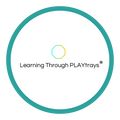Sensory Play for Tuff Trays | PLAYtrays

When it comes to early childhood education, sensory play is a valuable tool that can greatly enhance a child's learning experience. By engaging their senses, children are able to explore and understand the world around them in a more meaningful way. One popular method of incorporating sensory play into the classroom is through the use of sensory fillers in a tuff tray, such as sand, water, or rice.
But did you know that you can dye your own rice and create your own sensory bin filler? Let's explore the benefits of sensory play and how you can create your own sensory bin filler.
What is sensory play?
Sensory play is any activity that stimulates a child's senses - touch, sight, smell, taste, and hearing. It involves providing children with opportunities to explore and interact with materials that engage their senses. This type of play is not only fun, but it also promotes cognitive, physical, and social-emotional development.
What are the benefits of sensory play?
Sensory play offers a wide range of benefits for children.
Here are just a few:
1. Cognitive development: Sensory play helps children develop their cognitive skills, such as problem-solving, critical thinking, and decision-making. By manipulating different materials, children learn cause and effect, develop their creativity, and enhance their imagination.
2. Language development: Engaging in sensory play encourages children to communicate and express themselves. They can describe what they see, feel, and hear, which helps develop their vocabulary and language skills.
3. Fine motor skills: Sensory play often involves activities that require fine motor skills, such as pouring, scooping, and pinching. These activities help strengthen the muscles in their hands and fingers, improving their dexterity and coordination.
4. Social-emotional development: Sensory play provides opportunities for children to interact and play with others, promoting social skills such as sharing, taking turns, and cooperation. It also helps children regulate their emotions and develop self-control.
Creating your own sensory bin filler
If you're looking to add a personal touch to your sensory play activities, you can create your own sensory bin filler. One popular option is to dye rice in various colors. Here's how you can do it:
1. Start with plain uncooked white rice. You can use any type of rice, but long-grain rice works best.
2. Place the rice in a large ziplock bag or a container with a lid.
3. Add a few drops of food coloring to the rice. Start with a small amount and add more as needed to achieve the desired color. You can add a few drops of white vinegar to make it stick better and make the color more bright.
4. Seal the bag or container and shake it vigorously to distribute the food coloring evenly.
5. Spread the colored rice on a baking sheet or a tray lined with parchment paper to dry. This will prevent the rice from sticking together.
6. Once the rice is completely dry, it's ready to be used as a sensory bin filler.
Remember to supervise children during sensory play activities and ensure that the materials used are safe and age-appropriate.
Watch the video below to learn more about making RAINBOW RICE for your tuff tray.
In conclusion, sensory play is a valuable tool in early childhood education. By engaging children's senses, it promotes cognitive, physical, and social-emotional development. Incorporating sensory fillers, such as dyed rice, into your tuff tray activities can add an extra element of fun and creativity.
So why not give it a try and see the benefits for yourself?
Share your sensory play with us!
#learningthroughplaytrays 

